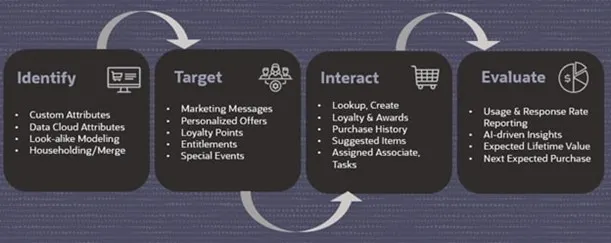We surveyed over 8,000 global consumers across four regions to find out what’s on their minds. As consumers continue to evolve the way they shop, retailers are pressed to increase agility to innovate faster and meet increasingly complex omnichannel demands.
In a recent webinar, Antony Wildey, Vice President of Global Sales Consulting, Oracle Retail, and I shared the latest consumer shopping trends along with seven strategies retailers can deploy to turn shopper insight into action. Let’s look at what retailers can do now to plan for the year ahead.
1. Place the customer at the center of the data model
In conversations we have with our retail customers and prospects, many collect deep customer data at the transaction level. But frequently, we see that only a few retailers put that customer data at the center of their data model, of their operating model, and embed that customer data into the process flows that they execute.
The Oracle Retail team has been looking at how retailers can take that transaction-level data that is tagged to a particular customer, collect it, organize it and then make sure it's available to machine learning and artificial intelligence techniques, so we can help improve the outcome of those business processes for retailers—from creating an assortment, predicting demand, bringing those two things together to come up with individual placement and pricing models, and of course, execution and customer journeys. We’ve been helping retailers identify which of the highest value processes they can embed that customer data into as they transition their data models from being focused on product, price and place, to including that fourth entity of customer data.

2. Understand how and what consumers want to buy
So given that you've now collected that customer data, you've started to organize that data, unify it and expose it to artificial intelligence; what can you anticipate better now that you have that in your model and have that transactional level data?
The first thing you see is an understanding, a real-time view of how customers shop. What are they doing? How are they doing it? What are they shopping for, and for how much? You can start to embed some artificial intelligence techniques to think about things like demand transference to help better understand that customer and the product they're after, the unique requirements of that interaction and how the products operate together. You can look at unique demand patterns for an individual location, an individual cluster, down to clusters of individual consumers.
That allows you to build an accurate localized assortment plan that considers where people are likely to shop and what they want in that location and automatically clusters and segments that customer base. What is the right channel mix? You have all sorts of questions you can start to answer about your customers and their interaction with your channels, your products and your staff.
3. Enhance the customer shopping journey
Now that you’ve got the customer data, you understand much more about what that customer wants and how they're shopping. You can use that data to exceed that customer's expectations by personalizing the shopping experience.
Identifying the customer's attributes and gathering data around them enables things like look-alike analysis. What did other customers that look like that customer do? You can start to anticipate their next action and target them with relevant messages, again, down to the offer level of interaction.
To take it a step further, some retailers want to understand the expected lifetime value of a customer rather than the historical lifetime value. By looking at who will be your best customers rather than who was your best customers, you can predict things like the expected next purchase date and tailor marketing offers around that.

4. Place inventory with intent
Once you understand your assortment plan, you’ve used artificial intelligence to ensure that it's highly accurate and localized; then, you can align that assortment. You can align the demand, inventory and receipt flow to ensure that you’re putting the product in precisely the right place at the point of fulfillment for the customer at the lowest cost point of fulfillment.
As a result, you are handling a product less, costing less, which builds up profitability and margin. This allows you to price with purpose by aligning the offer to the customer and their expectations, individualizing that offer and making recommendations. Having that customer transaction level data helps tailor the offer, but also place inventory in the right location and make sure that it's accurate inventory in the right location.
Retailers should leverage tools to tailor their inventory placement strategy and make sure that they’re operating at the highest possible margin point of view.
5. Deploy standard business best practices
While customer data influences and improves your decision-making, you can also leverage artificial intelligence to help automate best practices with detailed process-level documentation and intellectual property that all Oracle Retail customers get access to.
The Retail Reference Model provides a collection of detailed implementation information deriving from projects developed worldwide to help your team implement retail solutions faster and more efficiently.
- 650+ Business Process Flows
- 100+ Technical Models
- 1,100+ Retail Terms
6. Free up resources and people to innovate
Standardization and automation at best practice is the way to free up resources to create innovation within the retail organization. In a recent retail forum, Versace spoke about their innovation, exposing its highly accurate inventory at its store level in the Farfetch marketplace.
By doing so, they had massively increased the number of orders that were being taken on the marketplace by exposing their store inventory in real-time into the marketplace. They moved from taking about 1,000 orders per year in Farfetch in 2017 to being able to service 48,000 orders in 2021, all from four stores in EMEA and one in Hong Kong.
At the same time, they had deployed omnichannel orders within their stores, which have grown massively from about 3,000 in 2020 to nearly 18,000 in 2021 and 26,000 omnichannel orders in the first half of 2022—innovatively leveraging their store estate while freeing up resources.
7. Empower your team to execute
As the speed of retail continues to increase, once-weekly processes are moving to daily, and daily actions are now moving into real-time. Empower your team with the right tools to execute, innovate, and drive margin.

A single view lets a business user see what's happening in real time through a tailored role-based dashboard. The system provides recommendations for actions they should take to improve customer experience, margin, sell-through, pricing, or offer. Leverages tools that power the team to understand what's happening with the retail environment.
Retailers that can standardize processes around proven best practices and enable their teams with the right AI and machine learning tools will react quickly and build a blueprint for agility to serve their customers with the experience they prefer. Watch the full replay to learn how retailers that leverage the power of a retail platform will stay on top.
Oracle @ NRF 2023
Join Oracle at NRF January 15-17 at Booth #5121 for live demonstrations and conversation.










